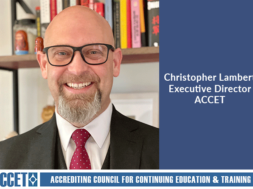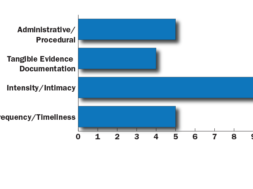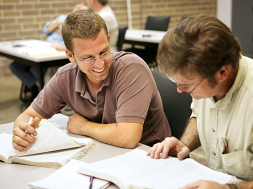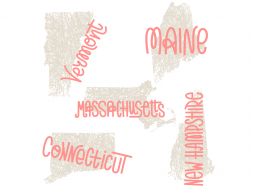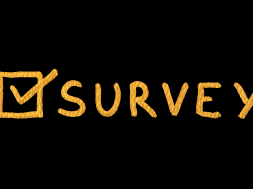
Accrediting Agencies Preparing for Virtual Site Visits
Written from interviews with ACCSC, DEAC, ACCET and ABHES
School accreditation visits will look different this fall, as accrediting agencies move to virtual site reviews with COVID-19 cases continuing to surge across the country.
But officials from four accrediting agencies said the virtual process will look similar to on-site visits, except, of course, that they will be done primarily online and will include more preplanning.
The four accrediting agencies are in different stages of doing virtual visits — some are currently doing pilots, others have started visits and some have not done either. But they all agreed that the key to making virtual visits work is to keep the process consistent with the physical site visits, and thus ensure a fair review.
The U.S Department of Education’s updated May 15, 2020 guidance extends accrediting agencies virtual evaluation visits through December 31, 2020. The guidance states: “We remind accrediting agencies that an on-site visit must follow a virtual site visit, in a timeframe that is reasonably practicable, and may be performed by staff or a trained site visitor and need not repeat the full review. A focused site visit to confirm the presence of facilities viewed during the virtual site visit and, if required by the accrediting agency, the opportunity to randomly select students to interview as part of the normal site visit process, is sufficient to meet the Department’s requirements for an on-site visit following a full virtual site visit.”
Accrediting Commission of Career Schools and Colleges – ACCSC
Michale McComis, executive director of the Accrediting Commission of Career Schools and Colleges, said ACCSC is currently doing a pilot virtual visit with 10 schools, and expects to begin doing virtual visits in earnest in mid-August.
Like the other accrediting agencies, ACCSC said that schools should largely expect a similar process from a virtual or on-site visit.
“Of course, the primary difference is being present,” he said. “The questions won’t be any different. The interviews won’t be any different. They just won’t be in the same room. The kinds of questions we ask will be the same. The manner in which we go about file reviews will be the same in terms of the information that we gather.”
Just like an on-site evaluation, someone at the school must be available to help should questions come up. School documents must be uploaded to a file-sharing account. Once the review is done and the report is written, those materials will be deleted from that account.
The tour of facilities is probably the biggest difference between virtual and on-site visits, McComis said.
“We’re asking institutions to do a fairly detailed video walk-through of the facility,” he said. “We want to see all the labs and classrooms, just as we would if we were walking through the school. We’ll then ask questions about that through the interview processes and compare that with the information that was provided in the self-evaluation report.”
ACCSC has also provided training for schools and evaluators, and as more volunteers sign on, they plan to do more extensive volunteer training. But they largely tell schools to prepare for a virtual visit just as they would for an on-site one.
“The real difference here is the technology and the platforms that we’ll use to convey the information between the groups,” he said.
So far, most of the questions have been what platforms they intend to use, and then providing training and support for those platforms, he said.
The use of virtual visits does offer one big positive: a lot of legwork is done before the visit begins. Still, ACCSC expects virtual visits to last two or three days.
“A lot of that information is being uploaded and team members and our staff are having an opportunity to look through a lot of it before we commence with the interviews,” he said. “It’s really helping to prepare them more and better for when the actual evaluation occurs.”
The schools haven’t been against or disappointed by the pilot virtual visits.
“The only feedback I’ve gotten … is that the on-site evaluation serves as a crescendo moment in the evaluation process,” he said. “Oftentimes a school wants to show off what they’ve done and what they have. Some may feel a little bit limited in that regard because there’s just so much more additional flavor that you get from being there in person when you can see it, feel it, taste it.”
ACCSC is looking for ways to simulate some of those things and make that “crescendo moment” in the evaluation process, he said.
“We want that sense of pride that comes through being able to show their peers the work that they’ve done on their way to success,” McComis said.
The pandemic certainly caused an increase in work as many institutions went to some variations of online learning quickly, and ACCSC worked with institutions through those approval processes.
“Now we’re working with institutions as they’re beginning to think about whether they want to offer distance education or hybrid education on a go-forward, not just in this temporary stage,” he said.
Whether they do it or not, institutions want to have the approval to do it beyond the Dec. 31, 2020 deadline, he said.
“They’re looking at what are the expectations to get approved to do this long-term,” he said. “It’s very different from what we asked for with the temporary approvals, understanding that was very quick. Having a Zoom account and access to the internet is not distance education. We have expectations that go well beyond some of the things that we were looking for in the temporary approvals. So institutions will need to be very cognizant of what those requirements are, and think about the extent to which they have the resources to be able to apply for distance education approval on a go-forward basis.”
In the meantime, McComis said they are telling institutions to keep them, the state and the DOE informed. “If you need something, have questions and need some guidance, we encourage you to reach out and contact us,” he said.
Distance Education Accrediting Commission – DEAC
Leah Matthews, executive director of the Distance Education Accrediting Commission, said DEAC has also been offering virtual visits since early July. Like the other accrediting agencies, she said schools can expect the virtual and on-site reviews to be similar.
“They can expect in-depth interviews by DEAC evaluators,” she said. “They can expect to provide evidence of compliance with accreditation standards. They can also expect to provide DEAC with live video tours of their facilities as needed, and a video conferencing system for DEAC to use at its platform for the assessment process.”
DEAC has utilized electronic record verification and assessment of online curriculum content, teaching, and learning in its review procedures for at least a decade.
But now that they have transitioned to a virtual format that also includes interviews and record verification typically reviewed on-premise in the past.
“While the transition for DEAC has been fairly smooth, I think that there could be challenges for other types of accrediting bodies that have significant verification requirements related to verifying the adequacy of physical classroom space, training equipment and laboratories,” Matthews said.
DEAC provided training seminars for their evaluators before launching its visits in July, and asked for reflections on that training.
“For the most part, our evaluators felt comfortable with the process,” Matthews said. “One feedback element that we received is that the coordination process for the virtual visit takes more time than we anticipated,” she said. “Our teams are meeting in advance of the virtual visit across multiple time zones. Coordinating schedules on the part of DEAC staff and our volunteers as well as institution representatives has been surprisingly time consuming.”
But one way they’ve addressed this is to have a Zoom meeting room open that is manned by DEAC staff throughout the virtual visit.
“In between the interviews and other breakout sessions, the evaluation team can pop in to talk with a DEAC staff member and other evaluators for support and guidance,” Matthews said. “That’s something that we learned from our pilot process; we needed to provide a real-time support system for DEAC evaluators during the virtual visit.”
Before entering the meeting room, DEAC utilizes virtual waiting rooms and verifies the identity of the participants. “Online security features are essential,” said Matthews. “Institutions are provided DEAC’s Virtual Site Visit Etiquette and Technology protocol, which has specific instructions on how to maintain security, including a requirement that no one who is not an approved individual on the agenda may participate, listen in, or otherwise observe the virtual visit.”
Other feedback from evaluators showed that they appreciated the opportunity to contribute to DEAC’s accreditation process without having to travel.
Matthews said: “We’ve found that there are advantages to the virtual format when there isn’t a hard stop because someone has a flight to catch. Our teams have appreciated the flexibility that the virtual format has afforded the evaluation process.”
On average, a virtual visit for accreditation renewal takes one day with the full team, followed by separate additional virtual meetings in specialty areas.
The main difference between a virtual and on-site visit is the record preparation and record security, she said. “For example, faculty files that would be available on-site for credential verification are now provided on a password protected and secured website,” said Matthews. “It’s the same with student records.”
DEAC is still doing student interviews and student evaluations, although some of that is now done in advance.
“We survey students in advance of the visit. We look at those results and it helps evaluators develop targeted inquiries in calls to students,” Matthews said. Sometimes students are called in advance of the virtual visit, and sometimes they’re called the day of if the team has specific questions they want addressed.
They also require schools to provide a virtual tour of their facility.
DEAC, too, is finding that virtual visits save schools money.
“DEAC implemented a virtual visit fee structure that removes costs associated with airfare, hotel and other travel-related expenses but still covers a modest honoraria for our public volunteer evaluators, costs associated with staffing requirements, and other administrative costs that DEAC incurs as part of the assessment process,” Matthews said. “We see no reason to maintain our existing visit fee structure when DEAC is not incurring costs for airfare and other travel-related expenses.”
Like the other agencies, DEAC also isn’t scheduling any on-site visits yet.
“DEAC has virtual visits scheduled through the end of this year,” Matthews said. “We are preparing to continue this approach in 2021 as needed. When we think it’s safe and appropriate to travel, we’ll take the necessary steps to conduct on-site follow-up visits.”
Accrediting Council for Continuing Education and Training – ACCET
Judy Hendrickson, interim executive director of the Accrediting Council for Continuing Education and Training, said ACCET conducted six virtual visits in May and June. All were focused visits — one day with one person.
They decided to do virtual one-day, one-person visits because they felt it was unfair to evaluate schools at the same time many of them were transitioning to temporary distance education due to the coronavirus, she said.
“We primarily used Zoom to communicate with the schools and it required the exchange and review of documents electronically,” she said.
But for this fall, Hendrickson said ACCET has scheduled 89 virtual visits over a three-month period, which will include postponed visits, as well as visits originally scheduled then.
She said the virtual visits will be very similar to on-site visits.
“The virtual visits will be substantially the same scope, focus and content as an on-site visit,” Hendrickson said. The virtual visits will follow a prearranged schedule, similar to on-site visits, with set times for interviews, classroom observations, fall reviews and debriefings.
“So it’s substantially the same in terms of the scope and content,” she said. “It’s just going to require a lot more preplanning and prescheduling.”
Tours of the facility and equipment will also be handled live virtually through Zoom. The school will basically take a camera and shoot a 365-degree panoramic view of the facility.
While schools should prepare for a virtual visit as if it is a physical visit, they also need to be organized in their preplanning and document exchange.
“When it comes to the document exchange, there’s a preparation checklist for the set of documents” (needed), she said. For the virtual visit, those documents need to be uploaded into a drop box two weeks prior to the visit. When it comes to selection of sample documents or student files to be reviewed, the team will select the current and former student files for review, give that information to the school and then the school will upload those samples.
Because of the difficulty of doing student interviews remotely, ACCET will administer student surveys.
“We’ll have a list in of all the current students and we will be sending them the survey in advance,” she said. “Then the results will be available to the team at the time of the visit.”
ACCET has also found that virtual visits save schools money. The ACCET commission voted to reduce its visit fee by about 13%, which also includes the cost of the on-site verification visit, she said.
The accrediting agency is also offering training for the schools, the evaluators and for the ACCET commission representatives who will be organizing and facilitating the virtual visits.
A July 24 virtual visit orientation for schools via Zoom was a success and had 230 participants. In short, schools learned what to expect and how to prepare for a virtual visit. Additional orientation sessions for the various stakeholders are scheduled this month and all are being recorded. So far, technology issues have created the most need for training, she said.
ACCET is waiting to schedule the follow-up physical visits since those won’t occur until 2021, Hendrickson said. In addition, they are waiting for more guidance from the DOE on those follow-up visits, she added.
But at a minimum, ACCET knows the follow-up visits will include three things: interviews with random students, verification of the facility and confirmation that corrective action was taken if an area of non-compliance was noted.
How job placement will be verified will depend on the COVID-19 situation at the time.
“Usually on an on-site visit, we sit down and call a sampling of employers to verify the start date for students with employment and verify that it’s training-related employment for at least 30 days,” she said. “We haven’t done this because in a COVID-19 world, we don’t want to bother employers with placement verification. What we will be doing during the virtual visit is placement verification, but basing it on supporting documentation that shows the start date for students, the position and so forth.”
Hendrickson said ACCET has also been working closely with its schools, noting that 88% have gone to temporary or distance education. Because of that high percentage, ACCET offered 10 free, 90-minute webinars on interactive distance learning — best practices, how to engage, track or retain students and so on.
“We’re certainly aware of challenges that (schools) have, particularly with labs and externships,” she said. “Just as the Department has extended temporary flexibilities in those areas, we have, too. If there’s not a prohibition by a licensing agency or at the state level, we are allowing simulated labs. We are allowing capstone (courses) in lieu of externships. But it has to be the student’s choice.”
Accrediting Bureau of Health Education Schools – ABHES
Amy Rowe, associate executive director of membership services with the Accrediting Bureau of Health Education Schools, said ABHES plans to start virtual visits later this month. They will likely do between 50-80 visits through Nov. 6, Rowe said, adding that number includes a variety of visits, including preliminary, full renewal, initial visit and everything in between.
“Schools should expect the virtual visit to be as close to the on-site visit as possible,” she said. “We are just really trying to make sure that schools are getting a fair review and the same review that they would get on-site.”
Some of the more noticeable changes will be that documents will now be shared electronically, the physical tour will be replaced with pre-recorded tours and the schedule will change.
“We normally have a fairly open schedule when we’re on-site, but we will have a very prescriptive schedule for the visit days,” Rowe said. “We normally didn’t have a meeting with the institution prior to our visit, and now we will have a pre-visit meeting with the institution and staff a week prior to the virtual visit.”
In-person interviews will be replaced by video conference interviews, while student surveys will be done electronically through SurveyMonkey.
Their on-site initial and renewal visits are normally two days in length, but ABHES is planning for 2½ days for the virtual visits, Rowe said.
ABHES, which is reducing its fees for the on-site visits, has created a document that highlights requirements for the institution and facility, as well as materials that will be required.
“We have a really detailed filing system of our meeting room materials – it’s folders and sub-folders and even a sub-sub-folder,” Rowe said. “We’ll provide the shell to the school. The school will fill those on their system and then they share those with the team. ABHES won’t have them to keep. It’s just like when you’re at the school. The meeting room materials are there for you for the day of the visit and then they stay there.”
Rowe said they are allowing schools to include photographs to supplement videos. If your school is taking a video of a lab with microscopes, the pan shot might be too quick to allow the evaluator to see the total number of microscopes. With a photo, they would be able to actually count those, she said.
ABHES plans to do more one-on-one customer service with the schools, Rowe said. But they have also discussed having an “Ask ABHES” session so they hear what questions schools have and then can formulate a presentation around those questions, she said.
Rowe said ABHES is doing evaluator training through a virtual visit webinar. Although only a few have gone through the training to date, the feedback has been very positive.
“There have been comments like ‘this is great’ and ‘it’s gone into so much more detail than we anticipated,’” Rowe said. Evaluators must do homework and take a test, allowing ABHES to ensure that each of the individual evaluators has an understanding of working online, going through folders, doing technology checks and more.
For now, the eventual follow-up physical visits will include a review of the physical facility and student surveys. But as things change with the pandemic, what a physical visit encompasses could evolve, she said.
ABHES had a “good amount” of schools submit for temporary approval of distance education programs, and many of them want to continue after the pandemic, Rowe said.
“Some schools didn’t think it would work, and they are so surprised at how well it’s going that they want to continue teaching this way,” she said. But health education will probably always have an element of on-ground instruction due to labs, competency check-offs and clinical experiences, she added.
Schools, however, are keeping abreast of state regulations and programmatic accreditor requirements with regards to clinical hours or externships, Rowe said.
“They’re very informative and keeping communication open with us as well,” she said. “Some schools have just kind of halted that area and are waiting for things to … become a little bit more normal. I’ve heard from others that say we can’t place enough externs. It really is a variety.”
ABHES is also extending its annual report due date. “I think a lot of agencies are doing that just for the workload of all of our institutions and programs,” Rowe said.
While the Department of Education has given accrediting agencies approval to do virtual site visits through Dec. 31, 2020, Rowe, McComis, Matthews and Hendrickson said they aren’t sure if the Department will extend that ending date.
“I think that the Department will continue to keep appraised of the pandemic situation and see what schools are doing,” Rowe said.
McComis wouldn’t speculate what the DOE would do either. “This pandemic has been changing daily since the beginning of the year,” he said. “It’s just so hard to predict anything.”
Matthews also said she can’t predict what the DOE will do, especially given the upcoming general election. “We’ll have to see what happens after the election results are confirmed,” she said.
Hendrickson said: “There are eight accrediting agencies that meet monthly and we talk about how we’re responding to COVID-19 and what flexibilities are being provided by the Department of Education and so forth. To my knowledge, none of us knows what’s going to be happening going forward.”
Interviews were conducted at the end of July 2020.


